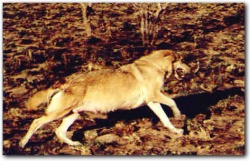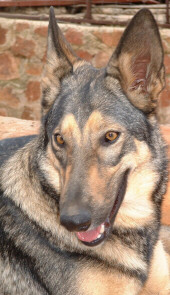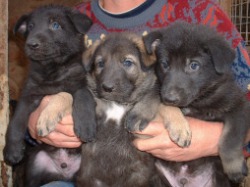German shepherd dogs
please support us
OLDERHILL WOLFDOGS
(Olderhill German Shepherd cross Canadian Wolf)

Currently an estimated 50,000 to 60,000 wolves inhabit Canada, the second-largest population in the world after the former Soviet Union. Historically, wolves inhabited virtually all regions of Canada, from the shores of the Great Lakes to the northern tip of Ellesmere Island, with the exception of Prince Edward Island, Anticosti Island and the Queen Charlotte Islands. (The northernmost wolf habitat in the world is about 83° north latitude, Cape Morris Jesup in neighboring Greenland.)
Today Canadian wolves occupy about 85 percent of their original range, and although wolf populations may be fluctuating in local areas, overall the number of wolves is considered stable. By comparison, there are about 10,000 wolves in the U.S. (more than half of which are in Alaska) and they occupy only a tiny fraction -about 5 percent - of their original range. In Canada, wolves may be legally hunted virtually everywhere except inside national/provincial park boundaries. Wolves in the U.S. have protected status as an endangered or threatened species everywhere except Alaska.
All wolves in Canada are members of the species gray wolf (Canis lupus). Four gray wolf subspecies are found in Canada: Canis lupus occidentalis (western Canada, as well as most of Alaska); Canis lupus nubilus (southeast Alaska and central and northeastern Canada); Canis lupus lycaon (southeastern Canada); and Canis lupus arctos (Arctic islands and Greenland), also known as Arctic wolves or white wolves.
Like their U.S. counterparts, wolves in Canada can range in color from coal black to off-white. Most of the wolves in Canada's high Arctic have pelage best described as a creamy white color. White hair shafts have more air pockets than those with pigmentation, thus providing better insulation in a climate that varies from cool in mid-summer to frigid during winter's darkness. Wolves inhabiting the most northern and western regions of the continent (including most of Canada and Alaska) are usually larger than their cousins in the Lower 48, an adaptation to the larger prey species they encounter (moose, caribou, musk oxen). Prey species for wolves in the Lower 48 are more likely to be deer or smaller mammals. On average, wolf packs are also larger in Alaska and Canada, where as many as 10 or 20 animals may stay together as a group.
Wolves have adapted to each of the diverse habitats and climates found in Canada's 3.8 million square miles. Envisioning wolves in the southern regions - amid prairies, forests and mountain valleys with plentiful vegetation and prey - is easy. But they also thrive in the far north (in far lower population densities) on tundra islands sealed in ice, snow and bitter cold nearly year-round, an environment seemingly too barren to support any large mammals. Like every living organism, their adaptation to the surrounding environment is ongoing: on the Queen Elizabeth Islands, there is evidence that wolves, which are known to scavenge the carcasses of seals killed by polar bears, may be learning to hunt seals on their own.
Sources of current information about Canada's wolves are as diverse as the territory they inhabit. In the south, the longest continuous wolf study in the world is ongoing in Ontario's Algonquin National Park, where researchers have studied wolves since the 1950s. Conversely, the current population of wolves in the far north Arctic Archipelago is virtually unknown. Best-guess numbers are gathered using anecdotal reports from villages, reports from hunters, and extrapolated by estimating the number of large prey animals in an area, then calculating by ratio the potential number of wolves they could support.
Today Canadian wolves occupy about 85 percent of their original range, and although wolf populations may be fluctuating in local areas, overall the number of wolves is considered stable. By comparison, there are about 10,000 wolves in the U.S. (more than half of which are in Alaska) and they occupy only a tiny fraction -about 5 percent - of their original range. In Canada, wolves may be legally hunted virtually everywhere except inside national/provincial park boundaries. Wolves in the U.S. have protected status as an endangered or threatened species everywhere except Alaska.
All wolves in Canada are members of the species gray wolf (Canis lupus). Four gray wolf subspecies are found in Canada: Canis lupus occidentalis (western Canada, as well as most of Alaska); Canis lupus nubilus (southeast Alaska and central and northeastern Canada); Canis lupus lycaon (southeastern Canada); and Canis lupus arctos (Arctic islands and Greenland), also known as Arctic wolves or white wolves.
Like their U.S. counterparts, wolves in Canada can range in color from coal black to off-white. Most of the wolves in Canada's high Arctic have pelage best described as a creamy white color. White hair shafts have more air pockets than those with pigmentation, thus providing better insulation in a climate that varies from cool in mid-summer to frigid during winter's darkness. Wolves inhabiting the most northern and western regions of the continent (including most of Canada and Alaska) are usually larger than their cousins in the Lower 48, an adaptation to the larger prey species they encounter (moose, caribou, musk oxen). Prey species for wolves in the Lower 48 are more likely to be deer or smaller mammals. On average, wolf packs are also larger in Alaska and Canada, where as many as 10 or 20 animals may stay together as a group.
Wolves have adapted to each of the diverse habitats and climates found in Canada's 3.8 million square miles. Envisioning wolves in the southern regions - amid prairies, forests and mountain valleys with plentiful vegetation and prey - is easy. But they also thrive in the far north (in far lower population densities) on tundra islands sealed in ice, snow and bitter cold nearly year-round, an environment seemingly too barren to support any large mammals. Like every living organism, their adaptation to the surrounding environment is ongoing: on the Queen Elizabeth Islands, there is evidence that wolves, which are known to scavenge the carcasses of seals killed by polar bears, may be learning to hunt seals on their own.
Sources of current information about Canada's wolves are as diverse as the territory they inhabit. In the south, the longest continuous wolf study in the world is ongoing in Ontario's Algonquin National Park, where researchers have studied wolves since the 1950s. Conversely, the current population of wolves in the far north Arctic Archipelago is virtually unknown. Best-guess numbers are gathered using anecdotal reports from villages, reports from hunters, and extrapolated by estimating the number of large prey animals in an area, then calculating by ratio the potential number of wolves they could support.
If you'd asked us what we thought of wolf cross german shepherds a couple of years ago we would have told you the following. From speaking to people involved with the military's wolfdog project here in South Africa and several private breeders, we understood that the hip problems found in their german shepherds were totally cancelled out by the wolf blood, and the longevity of the offspring was greatly increased. The drawback was that the temperament of the offspring was unsuitable for work until the percentage of wolf blood was reduced to 12.5 %. Higher percentages were skittish and unpredictable.
Then we met Shakira. (Photo above and right.)
She's 75% Canadian Wolf, 25% German Shepherd and has the looks and wild spirit of the wolf and body (40kg) and heart of a big shepherd. (At her previous home she pinned a burglar down by his throat for 3 hours until her owners came home!) She's very dominant and totally self-confident anywhere and seems fearless. Like a wolf she can't bark but answers our dogs by making short howls.
From the moment we saw Shakira we were bewitched and decided to let her have puppies with our Olderhill dogs. It took almost two years for her to accept a suitable mate, but finally, to our great excitement, she had a litter. Take a look!
Then we met Shakira. (Photo above and right.)
She's 75% Canadian Wolf, 25% German Shepherd and has the looks and wild spirit of the wolf and body (40kg) and heart of a big shepherd. (At her previous home she pinned a burglar down by his throat for 3 hours until her owners came home!) She's very dominant and totally self-confident anywhere and seems fearless. Like a wolf she can't bark but answers our dogs by making short howls.
From the moment we saw Shakira we were bewitched and decided to let her have puppies with our Olderhill dogs. It took almost two years for her to accept a suitable mate, but finally, to our great excitement, she had a litter. Take a look!



